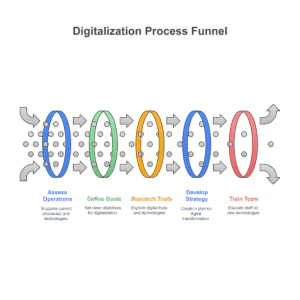Introduction
In today’s fast-changing marketplace, organizations are under pressure to adapt quickly while delivering meaningful customer experiences. This has given rise to agile digital transformation, a modern approach that blends the speed and flexibility of agile practices with the innovation of digital technology. Unlike traditional transformation efforts that often take years and involve heavy risks, agile digital transformation helps companies respond rapidly to change, improve operations, and unlock long-term value.
Businesses across industries are realizing that digital initiatives alone are not enough. What truly makes the difference is how those initiatives are executed. By combining agile methodology with digital transformation strategy, organizations can foster resilience, enable innovation, and deliver solutions that evolve with customer needs.
The Shift from Traditional Transformation to Agile
Historically, digital transformation was treated as a linear project. Companies invested heavily in technology platforms and long-term roadmaps, only to discover that customer expectations, market conditions, or even the tools themselves had shifted by the time the project was complete.
This rigid approach slowed progress, created bottlenecks, and often led to wasted investment. By contrast, agile transformation encourages incremental progress. With scaling agile practices, businesses can roll out solutions faster, test them with customers, and refine them in real time.
The move to scale agile methods ensures organizations can deliver value quickly without waiting years for results. In essence, it turns transformation from a one-time initiative into an ongoing journey of innovation.
Core Principles of Agile Digital Transformation
Agile digital transformation is rooted in principles that prioritize people, flexibility, and outcomes. These principles reshape how companies design processes, allocate resources, and measure performance.
1. Agile Practices and Principles
Agile practices emphasize collaboration, adaptability, and iterative delivery. Teams focus on smaller, manageable goals that can be tested, improved, and scaled. This not only reduces risks but also empowers employees to contribute to the transformation initiative actively.
2. Continuous Improvement
Transformation is not a final destination—it is a continuous process. By following agile methods, organizations stay responsive to digital technology shifts and emerging tools while ensuring that progress is measurable.
3. Value-Driven Outcomes
Instead of implementing technology for its own sake, agile digital transformation aligns each project with customer needs and business value. Customers are at the center of every decision, ensuring better design, stronger customer experience, and long-term growth.
Frameworks that Enable Agility in Transformation
Frameworks act as guides for scaling agile efforts across large enterprises. They help structure the workflow, align teams, and provide a disciplined approach to execution.
Scaled Agile Framework (SAFe)
The Scaled Agile Framework is one of the most widely adopted approaches for scaling agile. It organizes large programs into smaller, cross-functional teams while ensuring alignment with broader business goals. Within SAFe, the Agile Release Train drives continuous delivery of features and improvements.
Large Scale Agile Development
For companies dealing with complex systems, large scale agile development provides a structured way to integrate agility into software development, project management, and operations. It ensures consistency while enabling flexibility.
Other Agile Frameworks
Organizations may also adopt frameworks such as Scrum, Kanban, or hybrid models. Each agile framework emphasizes transparency, iterative progress, and accountability, allowing teams to select the structure that best fits their culture and transformation initiative.
Business Benefits of Agile Digital Transformation
The combination of agile methodology and digital transformation services unlocks measurable benefits for both customers and businesses.
Faster Time-to-Market
By adopting agile solutions, companies deliver features and updates quickly. This speed ensures that digital initiatives stay relevant in competitive industries.
Enhanced Customer Experience
Agility allows organizations to test new designs, collect feedback, and refine products faster. Customers experience improved performance, easier digital tools, and services that match their expectations.
Reduced Risks and Higher ROI
Incremental delivery means potential risks are identified early. Instead of spending years on a single solution, businesses spread investment across smaller projects, reducing financial risk and increasing the likelihood of success.
Driving Innovation
Agile digital transformation creates an environment where experimentation is encouraged. Companies can explore emerging technology and innovative digital solutions without fear of failure, building long-term capability.
Challenges and Risks
While agile digital transformation offers clear benefits, it also comes with challenges that organizations must address.
- Cultural resistance: Employees may struggle with adopting agile principles, preferring traditional methods.
- Leadership gaps: Without strong agile leadership or support from agile coaches, transformation efforts may lose momentum.
- Complex systems: Legacy technology and siloed processes can slow progress.
- Risk management: Even agile workflows require careful planning to minimize risks while delivering measurable outcomes.
The key to overcoming these challenges lies in engaging agile leaders, leveraging agile coaching, and aligning strategies with customer needs.
Real-World Applications
Many companies are already reaping the benefits of agile digital transformation. For example, enterprises in finance use agile frameworks to respond quickly to regulatory changes. Retailers leverage agile teams to improve e-commerce platforms and digital marketing strategies. Healthcare providers use agile workflows to enhance patient engagement through digital tools.
Each example highlights the adaptability of agile practices in different industries. Whether it’s scaling agile solutions for global enterprises or adopting smaller agile methods in startups, the outcomes are consistent: faster delivery, reduced costs, and improved customer satisfaction.
Best Practices for Successful Agile Digital Transformation
To ensure long-term success, organizations should adopt a set of best practices:
- Build Agile Teams
Small, cross-functional agile teams ensure collaboration across departments. A single agile team may focus on customer experience, while another works on digital technology implementation. - Align Strategy with Agile Methods
Transformation initiatives must be tied to a clear digital strategy. Agile methods work best when aligned with measurable business outcomes. - Leverage Data and Design
Data-driven insights and thoughtful design enhance decision-making. These elements ensure that transformation efforts are guided by customer needs rather than assumptions. - Invest in Agile Coaching
Engaging agile coaches helps teams adopt best practices, overcome barriers, and maximize performance. - Adopt the Right Tools
From project management platforms to collaborative digital tools, the right technology stack supports agile workflows and simplifies operations.
The Future of Agile Digital Transformation
As digital technology continues to evolve, the future of agile digital transformation looks promising. Organizations will increasingly combine disciplined agile frameworks with emerging technology to achieve scalable outcomes. Agile leaders will play a crucial role in guiding transformation initiatives, while agile practices will expand into new domains such as artificial intelligence, automation, and advanced digital marketing.
By embracing scalability, adaptability, and continuous improvement, businesses can ensure that their transformation efforts remain relevant for years to come.
Conclusion
Agile digital transformation is more than a buzzword—it is a powerful approach that helps companies adapt to change, reduce risks, and create lasting value. By scaling agile frameworks, adopting agile practices, and leveraging digital technology, organizations can achieve a balance of innovation and stability.
Those who embrace this approach not only improve their operations but also deliver services and solutions that resonate with customers. The journey may involve challenges, but with the right strategy, leadership, and agile methods, the rewards are transformative.
Ready to Begin Your Agile Digital Transformation Journey?
Driving digital transformation is not just about adopting tools—it’s about building scalable systems powered by agile solutions. Whether you’re exploring the scaled agile framework, fine-tuning agile practices, or planning your next digital transformation initiative, the right strategy can unlock innovation and measurable results.
At Softifyme, the team empowers businesses with proven digital transformation scale agile solutions designed to enhance performance, streamline processes, and deliver lasting value to customers.


